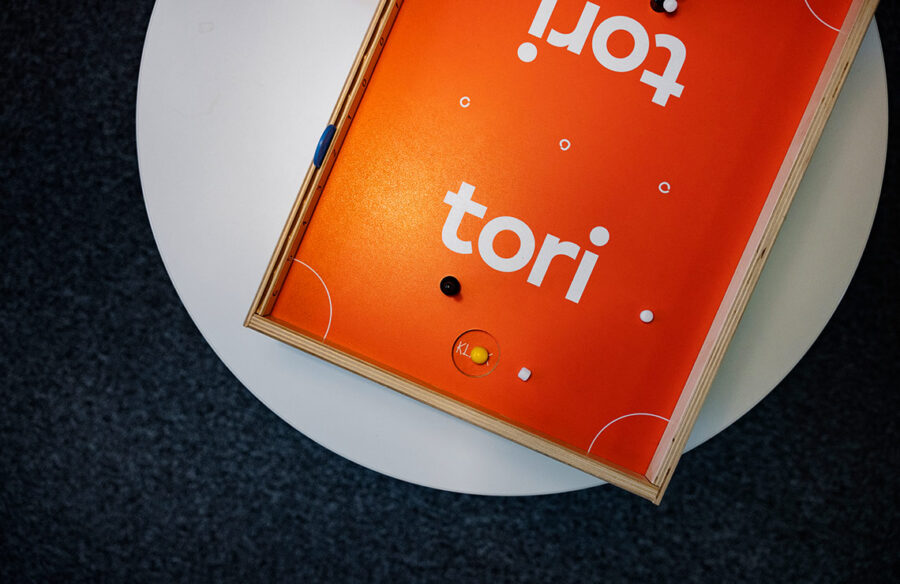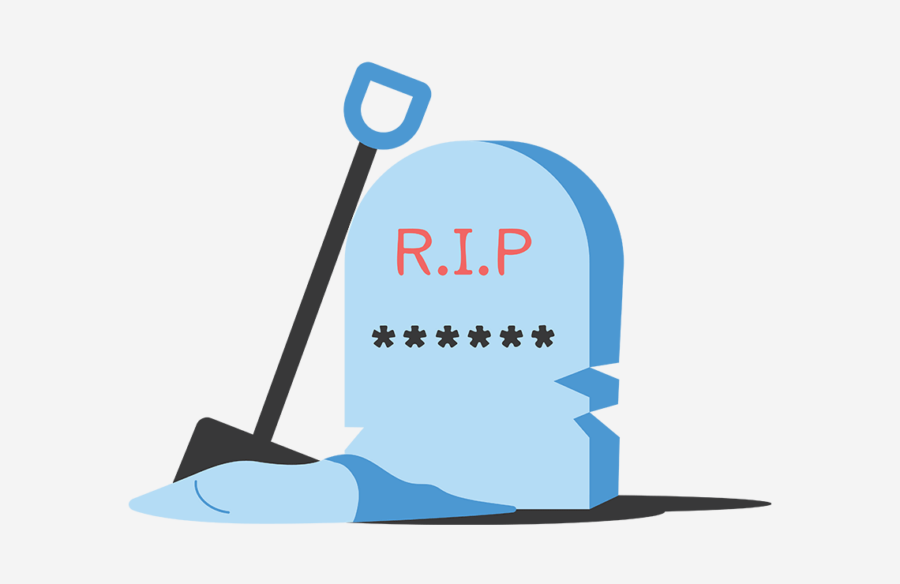IN/LAB is using experiments to reach news outsiders
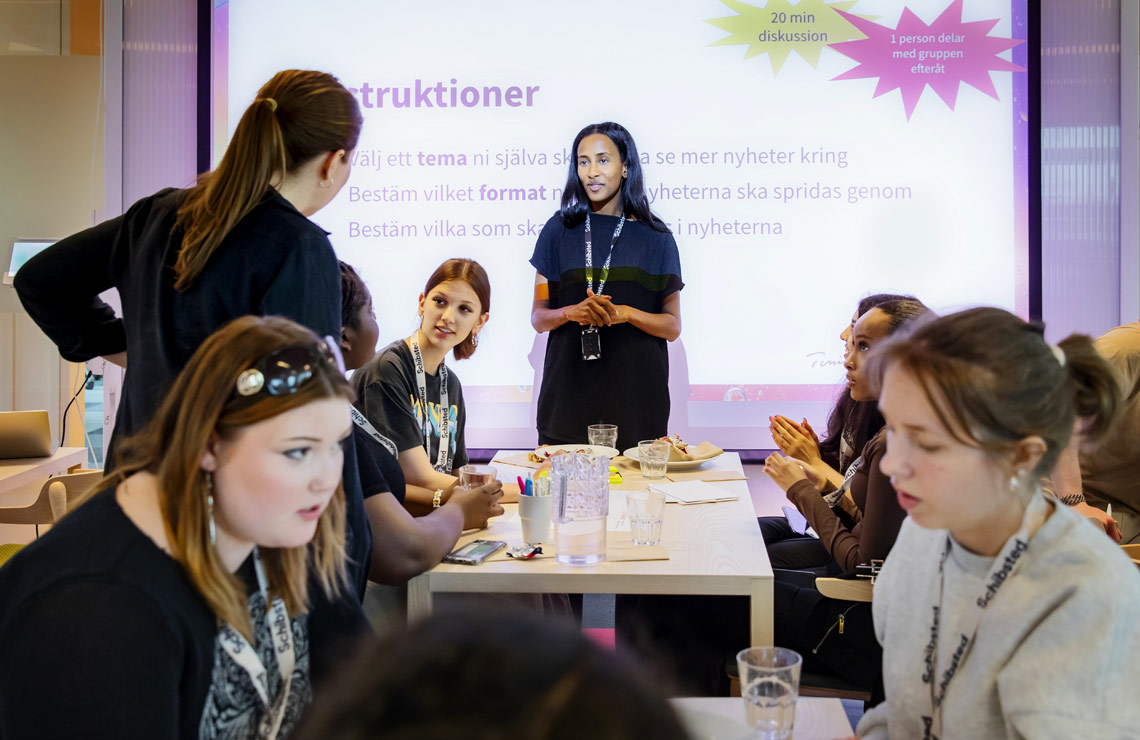
IN/LAB, a new initiative within Tinius Trust, running a workshop about future news experiences with summer workers from the local media house Fanzingo.
IN/LAB is using experiments to reach news outsiders
For a long time, the Scandinavian countries have been ahead of the game when it comes to freedom of speech and of the press. But today, large groups in society don’t consume fact-based journalism. To reach these “news outsiders” Schibsted and Tinius Trust established IN/LAB.
According to the 2022 edition of the Digital News Report (DNR) by the Reuters Institute for the Study of Journalism, 38% of global media consumers avoid the news (up from 29% in 2019). In Sweden and Norway, these numbers are 32% and 28%, respectively.
Independent news journalism plays a crucial role in serving people with fact-based information about the world around them. But if that journalism isn’t getting through to diverse groups in society, we have a big problem.
Future opportunities
To help Schibsted reach groups in society where the current consumption of independent news journalism is low, Schibsted and the Tinius Trust (Schibsted’s majority owner) established a joint venture in 2022: IN/LAB.
IN/LAB is here to prototype possible new(s) futures. To do that, we believe that we must dare to engage with truly divergent perspectives – not to legitimise, but to understand.
We use design thinking to turn insights about perceived pain points into future opportunities. In this, we are optimistic about emerging technologies and the opportunities they present for journalism. However, using it is not an end in itself. Our goal is to establish a trustful and constructive dialogue with groups we do not reach today and genuinely listen to their perspectives.
We work with specific target groups of news outsiders for various experiments. These groups vary in scope and size, based on factors such as age and gender, level of education and socio-economic status typically going into our scoping process.
Young people in the outskirts
Our first target group has been young people living in the multicultural outer city areas of Stockholm. These are areas characterised by, among other things, lower-than-average socio-economic status and residents with lower degrees of trust in society’s institutions compared to the national average.
Trust in Swedish media has been reported as increasing in the areas – but not among younger residents, who make up approximately 90,000 (under the age of 25) of the more than 250,000 people living there. We believe that this often expressed discontent and distrust in the media can have major negative consequences for the democratic and societal participation among this large group of young people.
We decided to work with 15- to 25-year-olds in the outer city areas who express a critical attitude towards news media. What are their perspectives on news journalism? What would we need to do differently to attract them as future consumers?
We have conducted in-depth interviews at local cafés, playgrounds and park benches and run creative workshops – always encouraging participants engage and express themselves in ways that are comfortable and relevant for them.
Three pain points
Through our research, we have identified three pain points in our target group’s current perspectives on news journalism:
They think that the news media shares unfair and inaccurate depictions of their residential areas and topics of importance to them.
They argue that there are too few perspectives, and too much opinion, in current news journalism. They want to make up their own minds based on facts – and not be fed other people’s opinions.
They have an instrumental approach to news but find the tools to be broken. If they can’t trust nor use what’s in the news, why consume it?
While in some ways a niche target group, we believe their expressed attitudes are critical to consider also from a broader Gen Z-perspective.
The bigger picture
Fundamentally, IN/LAB is concerned with the role that independent journalism plays in a liberal democracy. Because, as phrased by Hannah Arendt: “what makes it possible for a totalitarian or any other dictatorship to rule is that people are not informed”.
We want to turn insights about the realities of current news outsiders into future opportunities for Schibsted, our brands, and our users. To do that, we believe that empathy is our most important skill.

Belenn Rebecka Bekele
Community Researcher, IN/LAB
Years in Schibsted: 0.5

Agnes Stenbom
Head of IN/LAB
Years in Schibsted: 4.5
No human left behind

No human left behind
For one year, Sumeet Singh Patpatia has been Head of Diversity, Inclusion and Belonging at Schibsted. After collecting data one thing is clear – there is a lot of unleashed potential that could spur on innovation.
In a rapidly accelerating world, where markets, trends, customer behaviours and needs constantly evolve, companies must evolve as well. In addition to this, we face challenges of enormous complexity and scale – the climate crisis, energy costs, an uncertain macro-economic outlook and a war in Europe. Never has the need for different perspectives and inclusion been more urgent. With a greater range of diversity in the room comes a wider range of perspectives, ways of thinking, understanding behaviours – and greater responsibility.
Inclusion is about the ability to unleash the potential of all kinds of people, to make everyone thrive, feel seen and translate that to better products and services. And to have the right team in place to spot the relevant, changing needs. By broadening the range of diversity in our teams, the possibility to innovate and innovate even better increases.
Understanding how we can improve
That’s why we, for a year now, have been working on a plan to make Schibsted an even more diverse and inclusive place to work, a place where everyone should have a sense of belonging. We already do a lot, and in many ways, we are a diverse and meaningful home for more than 6,000 brave and adventurous employees. But it has also been crucial to really understand how we can improve. During the last year, we have been traveling around and meeting employees in every corner of the company to do some extensive data analysis.
We have conducted more than 100 internal interviews, three deep studies in three different organisations, and integrated the DIB-aspects in our internal survey. Our findings show that the majority of our employees find that we have an inclusive culture. But when 89% say we have a culture that is free from bullying, harassment and discrimination, you also need to consider that some still disagree.
And when in another survey, 9% find the environment evasive and passive and 3% say it’s segregating, you also need to acknowledge that people belonging to a majority feel more included than people belonging to minority groups.
Hidden diversity expertise
It’s sometimes easy to be satisfied with big numbers – but in order to really find out what is needed, you have to dig deeper. For instance, we also found out that there is a lot of hidden diversity expertise that is rarely or never taken into account. Such as people who have lived abroad, or perhaps people who are married to someone with a different culture experience.
No doubt, people do see the need for diversity and inclusion, and its connection to improved product development – and that curiosity is a key behaviour to support this. Our next step is to go from data to action, and to translate those perspectives into tangible value. We have also established local DIB groups in Finn, Blocket, Lendo, Aftenposten and our data and tech department already, and more will come.
And we have a DIB strategy in place – these are some of the actions we are focusing on now:
- Developing inclusive employee life cycle processes, starting off with creating an inclusive recruitment process playbook.
- Introduce programs and trainings to develop culture and competence within DIB.
- Implement a DIB maturity index – to really understand our state much deeper.
- Get insights about and understand customers that we don’t reach today.
But most important is to build competence throughout the organisation. In the end the responsibility to include all rests on both colleagues and leaders.
Because as humans, we exclude people consciously and unconsciously all the time. And being excluded is painful. It actually impacts our brain in the same manner as physical pain. Whether we weren´t selected in the football team as kids, never invited to the prom, or we find out that our friends, who we thought were close, got married and didn’t invite us. Whatever it is doesn’t matter – it all hurts.
When we feel excluded we limit ourselves
People around us may go to work and feel excluded every day. Having a feeling that they need to fit in to a specific culture, where you must park your unique perspectives in order to thrive. Perhaps not daring to share ideas in the product development room, lifting perspectives in the team meeting or always feeling misunderstood, because the context you are in doesn’t understand your angle.
We know that when we feel excluded, we limit ourselves. We might be afraid of opening up or sharing our perspectives or ideas. So, creating a culture in which everyone dares to share boils down to the responsibility of the leader and the colleagues. For colleagues, it is about our ability to invite and include perspectives (competence) of our colleagues with different experiences when we write or develop products. For leaders, it is about their ability to understand the full potential of everyone and making sure those perspectives are visible and that you as a leader listen to them.
Our vision in Schibsted is to develop the best workplace, a place where you can be you. And that is our main tool to empower all kinds of people in their daily lives. To make that happen, we need to keep on investigating, learning and following a clear plan.

Sumeet Singh Patpatia
Head of Diversity, Inclusion and Belonging
Years in Schibsted: 1
“Algorithms can encourage empathy and connections”

Victor Galaz is deputy director and associate professor at Stockholm Resilience Center, and a writer for Svenska Dagbladet.
“Algorithms can encourage empathy and connections”
Could AI make us care about the climate? Or will it just bring a flood of auto-generated disinformation? It’s Victor Galaz’s job to find out.
Next year, Routledge will publish Victor Galaz’s book Dark Machines, an essay on the impact of artificial intelligence in a future of climate change. As deputy director and associate professor at Stockholm Resilience Center (and a writer for Svenska Dagbladet), he spends a lot of time pondering resilience and sustainability. Over Zoom, from his home in Stockholm, he explains what makes for a resilient society.
“It’s a society with the capacity to predict, adapt to and recover from shocks. In that process, it also innovates and renews itself. For instance, the war in Ukraine and the pandemic pose huge challenges for global food systems, energy systems and so on. However, we shouldn’t strive to get back to normal from this point, because we need to change these things anyway. Our societies need to evolve.”
How resilient is our society?
“Different societies have different levels of resilience. A country with weak public institutions and little money is always more vulnerable than a country like Sweden. However, one difference between the world today and the world twenty years ago is that we’re much more global and interlinked. A disturbance in one part of the world rapidly spreads to other parts.”
Do we have the resilience needed for future challenges?
“We can never take that for granted. Climate change and loss of biological diversity pose massive challenges. Over time, our drive to optimise and maximise has created huge values for a lot of people. But we have never lived in a time of climate change like this one, and we simply don’t know yet if we can handle it.”
In his upcoming book, Victor Galaz explores how AI is cause for both hope and concern among climate scientists. He talks of a “silent tsunami” of AI seeping into
all aspects of our society – more or less unnoticed.
Is AI a threat in itself or is it a matter of who controls it?
“Technologies are not neutral. Some AI systems are explicitly designed to harm us, for instance through surveillance and discrimination of ethnic minorities. That said, it is a matter of control and of fair distribution of the enormous gains these new technologies bring.”
Regulating new technologies is a notoriously tough task. As the British academic and writer David Collingridge once pointed out: “When change is easy, the need for it cannot be foreseen; when the need for change is apparent, change has become expensive, difficult and time consuming.”
The challenge, then, is foreseeing the future. If we fail, AI will bring unintended and unwanted consequences, according to Victor Galaz.
”There are some direct climate effects of AI, such as energy costs, social costs and environmental impacts. We are coming to terms with these. But then there are indirect, long-term effects that are even bigger, and much harder to manage. Take digitalisation of agriculture, for instance. As we use technologies to optimise and maximise food production, we get enormous monocultures, as these are the most efficient, and we see the end of small-scale farming, loss of local job opportunities and more vulnerable ecosystems. And these are just some examples. Another is mass-scale climate disinformation through social media bots.”
If we do solve the problem of control, how can AI contribute to a resilient society?
“In two ways. Firstly, it will give us a better understanding of how our planet is changing, and how dependent we are on it. Secondly, it could help expand our empathy with other people and even with other species. Just as algorithms can exploit negative emotions to drive engagement in social media, they can encourage empathy and connection.”
“These and other emotions are important to bring about change. Just look at the mass appeal of Greta Thunberg. She is sad. She is disappointed. She is angry. These emotions make people care.”
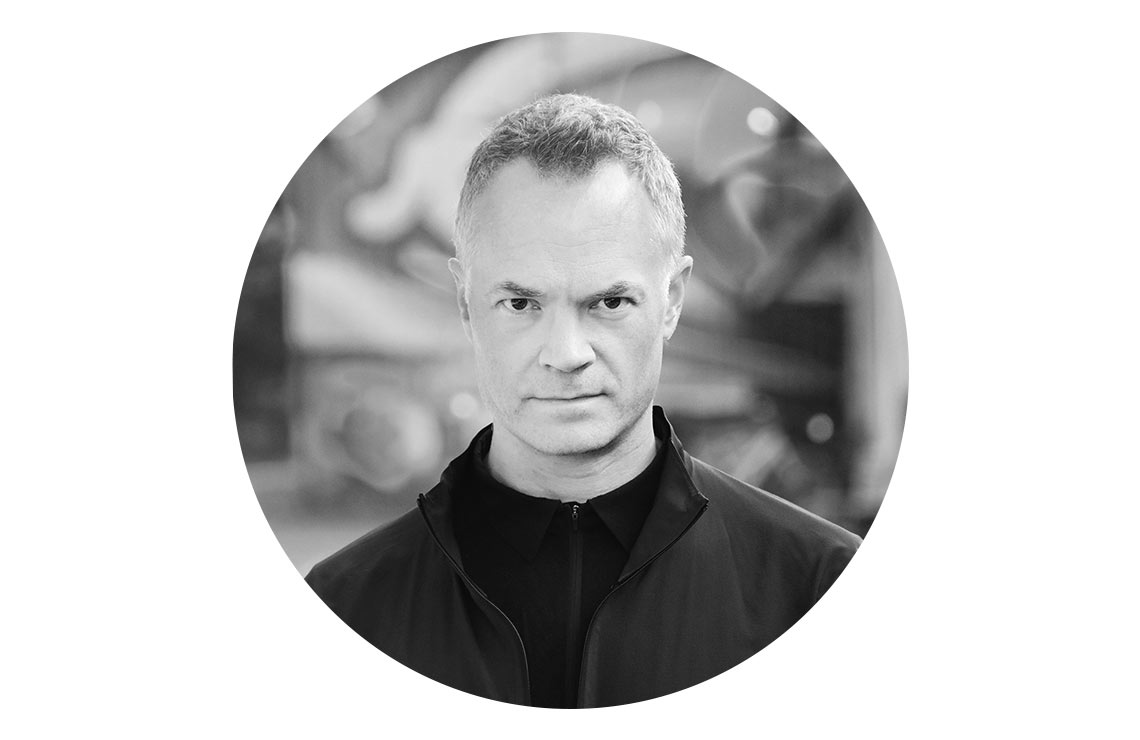
Sam Sundberg
Freelance writer, Svenska Dagbladet
A curious mindset makes us thrive in dark times

A curious mindset makes us thrive in dark times
Schibsted has a history of thriving during periods of disruption and when times are tough. Andrew Kvålseth, Chief Investment Officer, believes that the secret behind this success is an entrepreneurial culture that takes calculated bets and is willing to disrupt itself.
In California there are forests with tens of thousands of mighty redwood trees that have stood there for hundreds – and sometimes thousands – of years.
Slightly less common, but even mightier, are the sequoia trees. Some of them have been standing proud for more than 3,000 years in the Sierra mountains. The world’s most famous tech VC firm, Sequoia Capital, had a pretty good reason for picking their name from the famous tree. Sequoia has been an early investor in companies including Yahoo!, Google, YouTube, LinkedIn and WhatsApp, and an investment from them is considered an honour that often triggers a cascade of other investors wanting to join the investor ranks.
So, how do you live for thousands of years?
Well, the trick is almost awkwardly obvious. You don’t die. If you never die, you live forever.
Foundation for transformation
And the redwoods and the sequoias have a trick up their sleeve: A tannin in their bark that is flame retardant. That is, some weird scientific potion that helps them survive the forest fires that typically plague any large forest every 20–50 years or so. Besides this amazing chemical compound, their bark can be up to 12 centimetres thick. They’re like the tanks of the forest, almost impossible to kill.
So let’s bring this wooden metaphor home to Schibsted and the tech scene in the Nordics. Schibsted is a company with a number of valuable assets (including Aftenposten in Norway and Aftonbladet in Sweden) that were born in the 1800s, after the printing press but before the car was invented, and roughly 100 years before the humble transistors paved the way for the digital revolution. These companies survived the great depression in the 1930s and dozens of recessions in their 100+ year lives.
In late 1990s and early 2000s, these companies formed the foundation of a massive digital transformation taking place inside of Schibsted: The creation of our early, online marketplace business and a culture around innovation where we started partnering with some of the best entrepreneurs in the Nordics, both inside and outside of our company.
And it all could have ended there. The dotcom crash, our own version of a forest fire in 2002–2003, was so severe that some pundits back then actually thought that the Internet itself would contract and potentially disappear. But at the same time, consumers kept on moving online, kept on adapting to digital news consumption patterns, and they bought and sold their stuff online at a pace that led to continuous, massive changes in consumer behaviour.
Seeing permanent changes
Schibsted understood this. The mega trends and changes in consumer sentiment are for real and permanent. Revenues will come back. So will profits.
So, we doubled down on our marketplace business and in the next year, we began replicating our marketplace platforms globally.
The Lehman crash of 2008 was another massive forest fire in our industry. Ad revenues plummeted and many of the tech VCs that survived the dotcom crash were wiped out.
What did Schibsted do?
We invested in and built some of the most attractively valued and best-run tech assets in the Nordics and beyond, including Lendo, Kundkraft (sold to Tibber) and Leboncoin, to name a few. These and other organic and inorganic investments made during that time have created enormous value.
And now we’re here again. There are dark clouds over the global economy and perhaps even darker for us in Europe as we face compounded humanitarian crises with unstable energy markets and rising inflation.
But Schibsted sees opportunity during these times. And I think we might have found our secret formula for survival: A curious mindset that explores opportunities when few others see any. An entrepreneurial culture where we choose to take carefully calculated bets on those opportunities. And a culture of coming together to save money in different parts of our business to fund the new opportunities we see.
Based on our learnings, these are our five key strategies, when investing during hard times:
1. Think long-term – for real!
Booms and busts come and go but mega trends in consumer behaviour sometimes stretch across decades. Invest in long-term ideas and in people who never lose sight of their vision. Most companies you see turning into unicorns today were actually conceived 10-15 years ago and lived a quiet life outside the hype (as was the case for all our marketplace businesses at one point in time).
2. Stick to what you know and focus where you can add more value than others
Schibsted has tons of experience embedded in our various teams in the Nordics. We also have strong brands which reach the majority of the Nordic population daily. This is the time to use those assets and experiences and invest in ideas where we can help accelerate them beyond what other owners can.
3. Revenues are vanity, profits are sanity
A start-up or new organic business doesn’t necessarily need to be profitable in the near term. But your unit economics need to be! That is, selling a customer a product for 1 USD that costs you 2 USD to acquire is not a sound business model (it’s scary how often founders miss this).
4. Love your founders and leaders who can adapt to changing conditions
If the world changes, your plans need to change with it (although the vision can remain). Smart founders and leaders are the ones who are ready to pivot and change both strategies and short-term plans when customer sentiment rapidly changes or when the funding environment or technology evolves.
5. Understand that companies are built, not born
If you’ve built, or supported, an entrepreneur from company conception to success, you know that success truly is a factor of thousands of gruelling fights and mistakes. In a start-up, you chew glass and barbed wire for breakfast, but you always make sure to make one good decision for every two bad decisions. You also incorporate those tiny feedback loops from your customers into corporate strategy and culture on a weekly basis. Over months and years, those tiny, accumulated improvements could be tomorrow’s category winner.
Andrew Kvålseth
EVP, Chief Investment Officer
Years in Schibsted: 1
Living in war
September, 2022. When Aftenposten visits the military graveyard outside of Charkiv, workers have just started using excavators instead of digging by hand. Photo: Jan Tomas Espedal, Aftenposten
Campanyon makes nature accessible to everyone

Campanyon makes nature accessible to everyone
The way we travel is changing. During the pandemic the few opportunities left for travel were local and in nature, away from crowds. With tourism now back in full swing, the industry is signalling that this trend is here to stay. And Norwegian start-up Campanyon is at the forefront of it.
With over 10,000 bookable stays across more than 20 countries, the online booking platform Campanyon has already established itself as the leading platform for outdoor stays across the Nordics – only a year after launch. It’s now aiming to strengthen its position across Europe.
Talk to any entrepreneur and they’ll tell you that timing is critical in terms of both when to launch and to succeed with a new business. The same held true for Kristian Qwist Adolphsen and Alexander Raknes, the two founders of Campanyon, when they decided to explore Campanyon as a new business idea in spring 2020.
A passion for sports and the outdoors
The two originally met while studying at Copenhagen Business School, where they quickly became friends due to their shared passion for entrepreneurship, sports and the outdoors.They ended up working together at the digital marketing agency Precis Digital, and eventually, they both joined Google. It was there that the first ideas around Campanyon were formed.

After being sent home from the Google offices shortly after the Covid pandemic hit, the pair spotted some new and interesting trends emerging across various industries, as a direct result of the lockdown. One of the trends that captured their attention was the increasing appetite for being in nature, as people were longing to escape isolation but were banned from travelling abroad. This resulted in new records for nature-focused and camping-related search terms and overnight stays.
Alexander and Kristian decided to do more research on this budding market and quickly realised it was extremely difficult to both find and book places in nature in a seamless way, mainly due to it being a very fragmented market consisting of small platforms with limited supply. At the same time, they couldn’t find any platform in the Nordics that attempted to unlock unused private land for campers to book and stay.
“It was very clear from early on that the market and appetite for local, authentic, and nature-focused stays was growing. At the same time, there were very few established players offering user-friendly solutions – which we found interesting,” Kristian says.
Being an avid skier, surfer and mountaineer, Alexander could relate to the trend they were observing.
“I, too, had been longing for cheaper and more sustainable options to spend the night in nature, get local tips and meet like-minded people.”
Teamed up with former colleagues
Those insights led to the early-start of Campanyon, which began during late spring of 2020. A few months later, the two teamed up with former colleagues Aline Nieuwlaat, Sven Röder and Werner Huber, who all are very experienced with product engineering and UX design, and they quickly became Campanyon’s co-founders, too.
Aline was just wrapping up her work on a food app when Alex called her to let her know about the idea for Campanyon, something that immediately resonated with Aline.
“I’m a passionate camper so when Alex called, I was instantly committed to join the journey! Just before that I saw an ad from another player in the market and thought to myself how smart the idea was to offer private land to campers.”
Funnily enough, the five co-founders are based in five different countries. The first time they met in person after they started working on Campanyon was in December 2021 – the day they signed the deal with Schibsted Ventures in Oslo and around one-and-a-half years after they began working together on Campanyon.
Being born out of Covid and having a fully remote setup from day one, the team knew this would come with both opportunities and challenges. They have been fortunate to learn from leading companies, such as Google, on how to approach and adapt to working remotely and they have introduced some of the things that worked well directly into Campanyon, while skipping the things that weren’t quite as efficient.
In the early days, it was clear that too many initiatives were being launched all at once, to make everyone in the organisation comfortable with the new setting of working remotely. This meant almost daily check-in meetings, coffee huddles, shared lunch breaks and other attempts at creating a shared working experience – which to some extent had the opposite effect.
The tech team is the perfect example of Campanyon’s effective teamwork. For Sven, hiring and scaling has been a fantastic challenge and opportunity as the CTO. His team consists of a healthy mix of employees and freelancers from all over Europe.
“We have some incredible talent on board that is motivated to work in an ‘always on’ start-up environment. Open communication and cloud tools that support our development flow allow for rapid iterations of UI/UX and continuous updates of our services.”
Crucial to have local people on the ground
Campanyon has people working from nine different countries now, and nowhere is that more palpable than in the sales team. Kristian sees it as crucial to their success.
“Having local people on the ground across our key markets has been instrumental in growing both supply and demand. The local presence gives us the opportunity to establish relationships with key stakeholders and offer customer service at a different level, something that is particularly important in the Southern European markets we operate in.”
Campanyon got off to a great start since its launch in 2021. Or as Kristian puts it, they’ve been extremely busy growing since the launch.
“Since we launched the platform last year in April, we have grown from around 100 host listings in Denmark and Norway to more than 3,000 host listings across more than 20 markets.”
Alexander, who embodies the companionship that is core to the company’s ethos, visits many of the newly onboarded hosts to get feedback and foster a sense of community.
“I’ve already met a lot of campers and great hosts in unique places, and all of whom have stories that I want more people to hear.”
Campanyon experienced a huge appetite for joining the platform early on and they have used various channels to create awareness and grow the number of hosts in efficient ways.
“We have also seen a large number of organic signups from hosts in locations we don’t actively target, which is really funny and also inspiring, as we see the project resonates across so many different countries and cultures,” Kristian says.
Going forward, the focus for Campanyon will remain on growing in key markets in Europe to further establish their position as the leading platform for stays in nature, while continuing to enhance the user experience to become “campers’ best friend”.

Jeremy Sudibyo
Brand & Content, Campanyon
Years in Schibsted: 1
“These leaders know how to manipulate journalists”

Vegard Tenold Aase grew up in Norway’s second city, Bergen. He has written for Norwegian newspapers, as well as such American publications as Rolling Stone magazine and the New York Times. The Emmy-nominated journalist lives and works in New York and he’s specializing in extremism.
“These leaders know how to manipulate journalists”
Few journalists have interviewed as many extremists as Norwegian Vegard Tenold Aase, correspondent for New York-based VICE News. He urges colleagues not to take the task lightly.
“I know nothing about sports. That’s why I don’t write about sports. I don’t review operas either. Naturally, editors don’t send amateurs on those kinds of assignments. They understand that knowledge is the key to critical journalism. Yet extremism seems to be an exception. It seems they think any reporter is qualified to interview a fascist,” says Tenold Aase.
Vegard Tenold Aase faced a pistol pointed at his Adam’s apple at a Klu Klux Klan gathering. He was caught in the crossfire between neo-Nazis and anti-fascists wielding bricks. For several years, he lived close to American extremists, resulting in the book “Everything you love will burn: Inside the rebirth of white nationalism in America” in 2017.
More fascinated than appalled
“It started with me writing a thesis at Columbia University’s School of Journalism. Then I heard that there were neo-Nazis living in my neighborhood in Brooklyn. That was strange, I thought, being someone from orderly and tolerant Norway,” he says.
His first articles suggested that he was more fascinated than appalled by the extremism he was describing. That all changed on 22 July 2011, when terror attacks by a right-wing extremist left 77 people dead at home in Norway.
“I saw the need for deeper understanding, and I became more aware of the dangers of poorly founded journalism about extremism.”
Warned about inviting Bannon
When Trump’s then-adviser Steve Bannon was invited to Nordic Media Days in 2019, Tenold Aase was among those who warned against it. It may seem paradoxical that a journalist who had published interviews with countless conspiracy theorists and demagogues was critical about others giving the same kind of people a speaker’s podium.
“I’m not opposed to interviewing extremists, but we must know why we are doing it and we must understand how to do it. These leaders are calculating. They know how to appear more harmless than they are. They know what it takes to manipulate journalists,” he says.
Tenold Aase finds it disturbing to read cozy “fluff” interviews with neo-Nazis in major American newspapers. The basis seems to be that “these people could have been like you and me”.
“When I started covering extremists, they were as naive as I was. The majority weren’t used to the news media. So, it was easy for me, a bald and innocent foreigner from Bergen, Norway, to gain access. Now many extremists are professional communicators. In the United States, a new form of extremism has turned the country upside down.”
What can journalism contribute? What should we do to fight extremism?
“We need to take a step back. Here in the US, we experienced the storming of Congress, we have the QAnon movement, and a deep division in the population. But we must not assume that everyone who was there in Washington on January 6 were fascists and extremists. We need to explain where all that anger comes from.”
But is it possible for us – many people will think that we haven’t earned their trust; that liberal, privileged and urban journalists don’t understand their own era?
“That is correct here in the United States. The press hasn’t done a good enough job. I think the death of community journalism has had a big impact. People need journalists close to them who understand everyday life. We know that many white people are furious, they feel let down by the system. There are people who feel that they are deprived of opportunities. Such currents are far more journalistically interesting than interviewing individuals who have found answers in extremist ideology.”
What about the future here in the Nordics? Any advice?
“I have noticed the election results in Sweden and that certain circles are on the rise. My advice would be to understand why people are angry. There can be legitimate reasons for deep dissatisfaction. This is what journalism should highlight.”

Gard Steiro
Publisher, VG
Years in Schibsted: 22
Are we dreaming big enough

Are we dreaming big enough?
CRISPR-Cas9 has given us tools to rewrite life. The discovery on how to edit our genes is said to be the holy grail of science with possibility to fix gene disorders and improve people’s lives. Yet, not that many treatments or applications has been developed. How come?
A few years ago, American biochemist and Nobel prize winner Jennifer Doudna was working on her laptop in an airport lounge in New Jersey, when a couple walking by with their two boys caught her attention. The younger boy made his way on crutches, displaying signs of a hereditary disease called muscular dystrophy.
“Generally manifesting in childhood, the disease steadily robs those who have it of their ability to walk. Eventually, I knew, the crutches would no longer be enough,” she recalled in an article in The Atlantic.
Doudna had just come from a meeting where a cure for the boy’s disease appeared possible, using CRISPR technology to rewrite the DNA of kids just like him.
“Imagining how the technology I’d helped create could change this boy’s life, I was overwhelmed with emotion. Beyond hope and wonder, I was filled with a sense of fierce urgency to expand CRISPR’s impact to the people around the world who need it most,” she wrote.
In 2020, Jennifer Doudna and Emmanuelle Charpentier received the 2020 Nobel Prize in Chemistry “for the development of a method for genome editing”, known as CRISPR-Cas9. As with many great scientific achievements, scientists before them had made ground-breaking discoveries that paved the way for their work.
The potential of their discovery seems endless.
In 1987, Japanese molecular biologist Yoshizumi Ishino and his colleagues discovered a protein named Cas9 found in the Streptococcus bacterial “CRISPR” immune system that co-operates with guide RNA and works like scissors. The protein slices up the DNA of viruses, preventing them from infecting the bacterium. This natural defence system was later characterised by the Spanish molecular biologist and microbiologist Francisco Mojica. However, it was Doudna and Charpentier who showed, in 2012, that they could use different RNAs to program the protein to cut and edit different DNA. The potential of their discovery seems endless.
The blueprint of our lives
“It’s a little scary, quite honestly,” Doudna told The New York Times about the possibilities of our CRISPR future. “But it’s also quite exciting.”
Our DNA is called the blueprint of life. It contains the genetic code, which is essentially the instructions for creating an organism. By altering our DNA, we can, in a sense, rewrite the rules of life. Our eye colour, hair colour, height and the size of our noses – it’s all determined by our genes. Unfortunately, errors in our DNA can cause severe diseases. Sickle cell disease, Cystic fibrosis, Down syndrome and Huntington’s disease are examples of genetic disorders.
“If we could go in and fix these mistakes, we could save many, many lives and get rid of these diseases,” philanthropist Bill Gates has explained. Editing DNA with precision has, as he puts it, been the holy grail for scientists for decades. His foundation is funding work to see if CRISPR can be used to knock out mosquito populations dramatically, as well as to make better seeds, help with very accurate diagnostics, and lead to cure for HIV and things like sickle cell. CRISPR has also been used to enable T-cells (a part of the immune system that focuses on specific foreign particles) to find and destroy cancer cells.
As Gates points out, using the CRISPR gene editing tool for curing diseases isn’t very controversial. The idea of changing the DNA that determines your baby’s eye colour or skin tone, however, is another story. Most scientists agree that this is something we should not do. But where should we draw the line? And how do we make sure we don’t cross it?
It needs a push
In her article, Jennifer Doudna writes that the advances made so far – and those still to come in preventive medicine, diagnostics, agriculture, biomanufacturing and synthetic biology – promise to improve the lives of millions of people. They’ve also launched companies and helped existing ones break new ground. This growing CRISPR economy was estimated at USD 5.2 billion in 2020. Venture capitalists poured more than USD 1 billion into the growing ecosystem of genome-editing companies in 2021 alone.
“Sometimes, when I think about my part in all this, I am overcome,” Doudna writes. At the same time, she asks: Are we dreaming big enough? Moving quickly enough?
Her answer is “no”. She compares it with cell phones, which went from a niche luxury technology to outnumbering the human population, creating new economies and changing the way we live. For the CRISPR technology to be widely adopted, it needs a push, just like mobile phones did, Doudna argues.
“Realizing CRISPR’s full potential will require many more of us to come together. (…) Academic scientists, industry researchers, investors, policymakers and members of the public each have a role to play,” she concludes.
Positive reactions
After reading Doudna’s article, I couldn’t help but wonder why more wasn’t being done to make sure we seize this possibility to improve the lives of so many people. Here we have a pioneer of her field, waving her incredible tool, urging the world to see its potential and use it. I was curious to know if she had received any reactions to the article. Had it been the wake-up call she might have hoped?
In an e-mail, Doudna’s Lab Coordinator Keana Lucas assured me that the reactions to The Atlantic op-ed were positive.
“At this 10th-anniversary mark, it’s clear that CRISPR tech has made remarkable progress. Winning the Nobel has only brightened the spotlight and amount of investment and engagement in a technology that promises to positively change our health and the health of our world,” she told me.
A Swiss army knife
What about Emmanuelle Charpentier? Where does she stand on all this? Emmanuelle Charpentier is a French professor and researcher in microbiology, genetics and biochemistry. As of 2015, she has been a director at the Max Planck Institute for Infection Biology in Berlin. Between 2009 and 2017, she worked as a research director and guest researcher at Umeå University in Sweden. In a video clip on the University’s website from 2015 – five years before she received the Nobel prize – Charpentier explained her discovery as “a Swiss army knife that allows repairing genes”.
“If you want to discover something important, you need to ask maybe crazy questions. It is when I came to Umeå that I developed a project that was to somehow bring together two different mechanisms that became the CRISPR-Cas9 mechanism,” she says, adding that her ultimate wish is that the technology be used to treat serious genetic disorders.
She believes that one of the greatest dangers we face is that the basic sciences are no longer attractive to young people.
In 2019, Charpentier founded a company called CRISPR Therapeutics. In 2022, the company published preliminary results from a clinical trial showing that 15 patients with beta thalassemia – a severe type of anaemia that requires lifelong reliance on blood transfusions – had gone months without needing transfusions after receiving a drug that edited the gene that caused the disease. In an interview with El País, she explained that she is focused on looking for new forms of gene editing to combat antibiotic-resistant infections. She also said she believes that one of the greatest dangers we face is that the basic sciences are no longer attractive to young people, people who will need to invent new treatments and medicines in the future.
“I think we all – and especially young people – need to ask ourselves what kind of world we want to live in,” she told the Spanish newspaper.
Marcus Jarås is a Swedish associate professor at the Department of Clinical Genetics at Lund University. His work focuses on using CRISPR to find new targets for cancer treatments. Using CRISPR to better understand the biology behind different diseases is the most common way of using the technology today, he explains. Swedish scientists were quick to start using the CRISPR technology, but as far as Jarås knows, it hasn’t led to any new treatments yet. That isn’t surprising, however, considering that it normally takes ten years from discovery to approval of a new treatment.
Use of CRISPR as a gene therapeutic treatment is further complicated by the fact that there are patents in the field that require licenses for technical commercial services, Jarås adds. In part, he shares Doudna’s analysis that CRISPR needs a nudge.
“More can always be done, but I still think that CRISPR has very quickly established itself as a powerful new tool for gene editing, not least in biomedical research. On the other hand, things are slow with CRISPR in plant breeding due to the GMO debate that led to EU legislation that makes it difficult to use this technology. In this area, CRISPR could really use a push,” he says.
Needs to be handle with caution
But if CRISPR can fix errors in our DNA code, could it also accidentally cause them harm? According to Swedish researchers at Uppsala University, who’ve experimented with editing the DNA of zebrafish using the tool, the answer is “yes”. Their studies show that there were several types of unexpected changes to the fish DNA.
Sometimes, larger parts of the DNA than intended were changed. Other times, the edits were made in the wrong part of the genetic material. The researchers also saw that the mutations could be passed on to future generations of zebrafish since they had occurred in fertilized egg cells. The techniques currently being developed for humans, however, are not using reproductive cells. There is, in other words, no risk that the changes – good or bad – can be passed on to the offspring.
The point of the research, according to the scientists, is not to suggest that gene scissors are an unfit tool for treatment. Only, that it needs to be handled with caution. The Uppsala University team is now focusing on improving the safety of CRISPR-
Cas9 therapies, where cells from a patient are genetically enhanced outside of the body and reinjected as a treatment.
“Such treatments are now being developed for a wide range of diseases. Our aim is to develop efficient methods to screen for unwanted mutations in the genetically modified cells,” says Adam Ameur, Associate Professor at the Science for Life Laboratory at Uppsala University.
So, the question remains – are we using this tool to its full potential – and if not, what possible advancements are we missing out on when it comes to decreasing pain and suffering? Is it the idea of rewriting the rules for life that is holding us back, or is it simply the time it takes to make sure we get it right? Not even the inventors of the technology seem to know the answer.

Mikaela Åkerman
Editor, Omni
Years in Schibsted: 8
Our sonic attention is worth fighting for
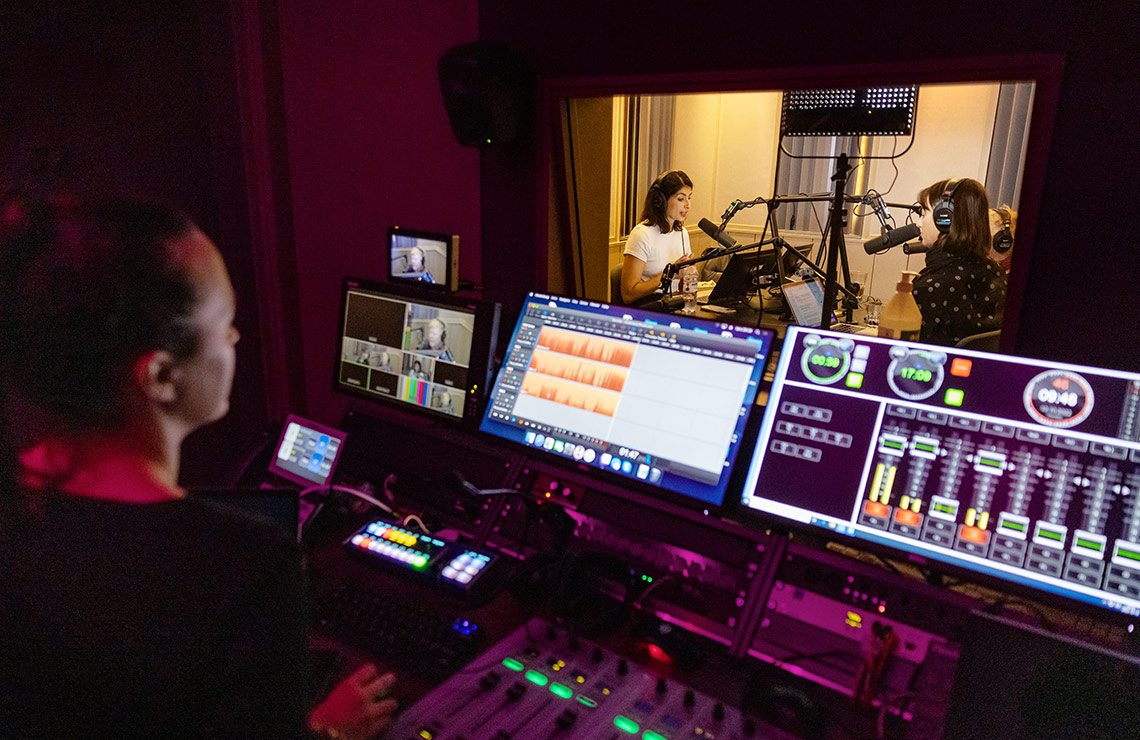
The politics podcast “En runda till” (“One more round”) with Soraya Hashim, My Rohwedder and Lena Mellin is recorded in Aftonbladet’s studio in Stockholm.
Our sonic attention is worth fighting for
While companies around the world are engaged in an intensifying battle for users’ screen time, the rise of audio might be the next frontier in winning user attention.
Fuelled by wireless headset adoption and an ever-growing selection of content made for listening, the audio trend represents a major opportunity for any company that aims to be relevant during all those moments that users are away from their screens.
Although we cannot accurately predict how much total screen time (and news publishers’ share of it) will grow in the coming years, we clearly see that time spent on audio is growing rapidly. Around the world, more and more people listen regularly, and each person listens for a longer period of time.
In Norway, the share of users listening to podcasts per month has nearly doubled, from 24% in 2017 to 43% in 2020, with Norwegian-language podcasts leading the charge. Users aged 16 to 24 show the highest adoption rates, with listeners in this group averaging nearly two hours per day on podcasts or audiobooks. Among Swedish users in general, average time spent on podcasts and radio daily already matches that of digital news consumption.
Different from radio
While audio as a product is nothing new per se, there are many ways in which the current move to audio is different from traditional broadcast radio:
- It is fuelled partially by hardware adoption, led by AirPods’ exponential growth, having captured more than one-third of the wireless earbuds market. And several other wearable devices have also seen double-digit sales growth over the last few years. A 2022 report estimates that three in four US teens now own AirPods. The convenience of these new devices means people now wear headphones more often and in situations they previously wouldn’t – even while talking to their friends!
- Our mobile devices are always connected, enabling users to listen to any topic, any time, while doing other things. The ability to multitask is, as one would expect, one of the main reasons users turn to audio in their busy lives.
- Lastly, the sheer volume of content is growing rapidly, with an entire publishing industry transitioning to audio books, and all-time-high investments from tech- and media companies going into the podcast industry.
As users move to airpods for consuming content, we also see that several audio-first start-ups have emerged over the past few years. In addition, industry experts talk about wearable audio as the first mass market adoption of augmented reality devices. For many young users, audio is their primary channel for news. Clearly, publishers who want to stay relevant must find their place in the audio domain.
For news organisations, understanding the opportunity that comes with audio starts with acknowledging how the newspaper landscape has changed. We’ve gone from a world of physically distributed newspapers, where there was little competition and a general scarcity of information, to a world of unlimited digital distribution and global competition for attention. In this world, news organisations are not just competing against each other, but rather against any company distributing their product on a screen. Those other companies include technology giants with massive budgets and a world-class ability to get users addicted to their products.
News attracts users attention
We know that tech and streaming giants dominate users’ visual attention, and it seems unlikely that news publishers will turn the tide on that anytime soon. But in the audio world, news as a category gets an outsized share of users’ attention, accounting for 30% of top podcast episodes despite comprising only 7% of podcasts.
However, increasing audio content production for news organisations does not come without its challenges:
- The cost for voice actors and studio time remains high
- Recording and editing takes several times that of actual audio output
- There’s a risk of spending significant resources on content of low interest
The nature of news as perishable limits the types of content that can be produced without becoming outdated as stories evolve. Today, publishers mostly accept the fact that investments in the audio domain are expensive, and that it will be worth the effort in the long run. But there are also ways that technology can enable production of more audio in smarter ways.
Firstly, the need for studios may soon disappear, as cheaper and more mobile recording setups hit the market. Companies like Nomono (which Schibsted recently invested in) are challenging the existing workflow as well as the costs associated with high-quality podcast production.
Secondly, for narrated articles, we might soon get rid of the need for both studios and narrators entirely as text-to-speech technology matures. A synthetic voice that can read any text input out loud offers some unique advantages. It allows for unlimited production of narrated articles with near zero marginal cost, as it converts a written text into audio within seconds. Since it is connected to the publisher’s CMS, it also enables flexibility to update and edit published stories, without ever needing to step into a studio. The fact that it can be scaled across the entire daily article output of a newspaper also means that users can rely on the feature to listen to any article they prefer and do so while commuting or cooking at home. Since many users cancel their subscriptions because they simply don’t have enough time to sit down and read all the articles they pay for every day, solving this “bad conscience-problem” for subscribers might be a key factor in reducing the churn rates most newspapers are seeing.
Listeners complete more of a story
Early results from text-to-speech experiments in Aftenposten show that the gap between human and synthetic voices is closing in terms of listener retention, and that users opting for audio consumption complete more of each story compared to text. Plans for enabling users to save stories for later listening, as well as the ability to queue synthetically narrated articles after premium flagship podcasts, may all lead to more widespread adoption of audio as a mode of news consumption. The result might be a significant increase in the total time users spend engaging with Aftenposten’s journalism each day – read more about it on the next page.
Looking back at the battle for users’ screen time, as described earlier, could it be that by focusing on users’ eyeballs, we miss an emerging behaviour change that may one day account for most of our time? The next frontier in winning user attention might in fact be about sonic attention, and those who make the right investments now may be on a course to become the giants of the audio world.
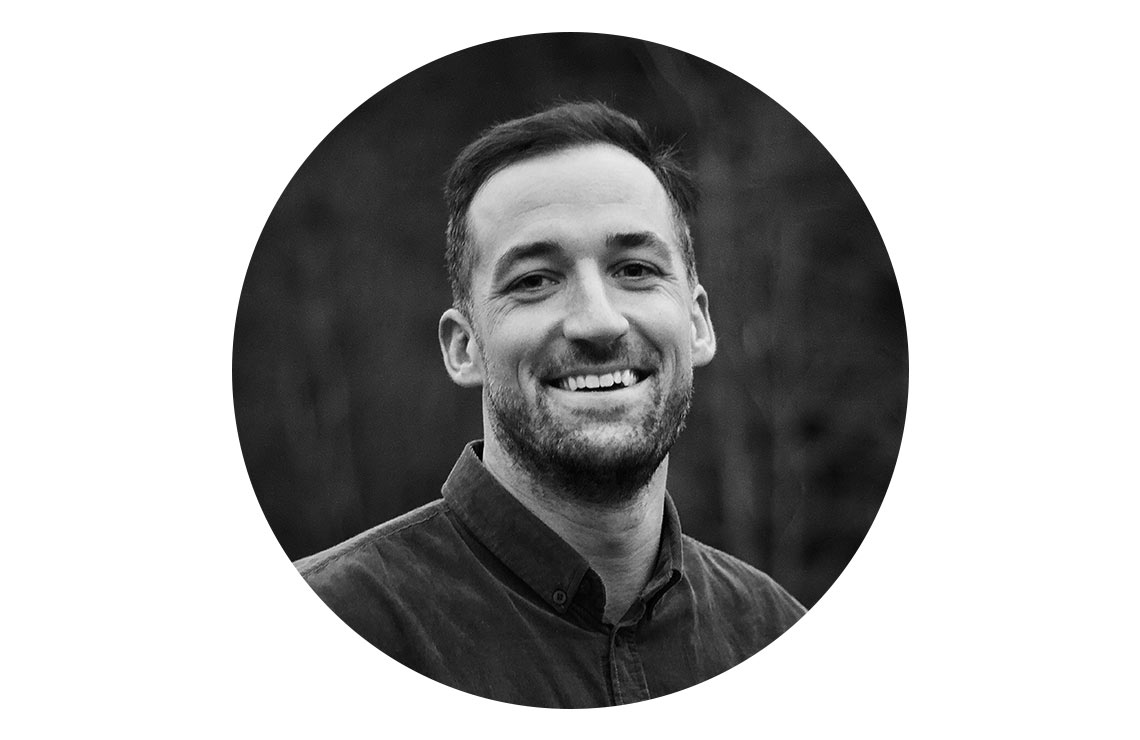
Karl Oskar Teien
Director of Product, Schibsted Subscription Newspapers
Years in Schibsted: 8
A local news focus brought BT back from the brink

Starting in 2021, Bergens Tidende published a series of investigations on Rolls-Royce’s sale of Bergen Engines to a Russian holding company. The newspaper was awarded Norway’s most prestigious journalism award for the reports.
A local news focus brought BT back from the brink
In only six years, Bergens Tidende went from crisis to “digitally sustainable”. A clear local focus, live reporting and investigative journalism have made the readers happy.
Bergens Tidende’s business had been booming for decades. At its peak, the newspaper reached about 260,000 readers every day, with 100,000 copies in circulation. The paper, as it was said, “printed money”. But as the media crisis hit, the glory days soon vanished. By 2015, BT was facing the wall. The model wasn’t working.
Six years later, in December 2021, the tables had turned yet again. Øyulf Hjertenes, the director of Schibsted Kyst and Chairman of the Board at Bergens Tidende, declared BT to be “digitally sustainable”. He explains:
“If BT closed down the printed edition tomorrow, digital revenues from subscription and ads will uphold a strong newsroom. The paper will still be able to keep holding power to account in Bergen. Back in 2015, most people didn’t believe this would be possible,” Hjertenes says.
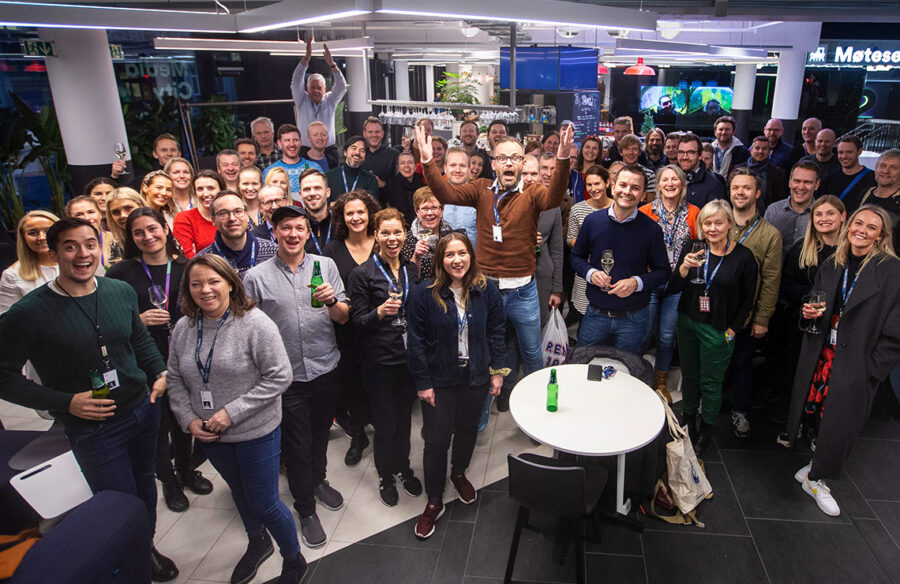
What made this comeback possible?
Back in 2015 subscriber numbers were dropping fast, and the economy was in a bad shape. Print revenues kept falling, and a digital business model mainly based on ads and pageviews were not producing sufficient results. Costs of NOK 50 million had to be cut. The printed Sunday edition was shut down and one out of five journalists had to leave. The financial forecasts were bleak and nowhere near digital sustainability.
Something had to change.
A clear and ambitious goal
The turnaround was enabled by a clear and ambitious goal: 50,000 digital subscribers in three years. In the BT newsroom, it became known as the “50k strategy”. It drastically changed BT’s way of working, priorities across the whole newsroom, consumer business and product and technology.
The strategy outlined new priorities for everyone and set up ten pillars for improvement. BT would prioritise live reporting and longform quality journalism – and do less of the “in-between”. There would be fewer stories, stronger focus on unique local reporting, while letting go of most generic national and international stories. BT wanted to bolster its position as the primary news destination in Bergen. The entire organisation was tailored towards being subscriber-centric.
Introduced new tools
In the coming years, new tools for live reporting, storytelling, data analytics, debate and reader involvement were introduced. Algorithms were implemented on the frontpage, and data and insight capabilities were introduced in the newsroom. Cross-functional work became the norm, performance numbers were posted front and centre at the offices, and staff started celebrating major shared milestones.
Live reporting became especially important. A specific improvement point identified in 2015 was to find better ways to convey brief, developing news to readers. The news feed “Trafikken direkte” (Traffic Direct) was established to meet the needs of the users for live traffic reporting.
Successful updates
Bergen is a city with a vulnerable infrastructure. One accident in the main road tunnel is enough to make half the population late for dinner. Instead of spreading a few short news items across the BT.no front page, these updates were gathered in one place, harnessing traffic data for added value. This has become BT’s best-selling digital product.
“We were quite early to use live news studios. In fact, the tool first developed here has now been adopted in several parts of Schibsted,” says Liv Okkenhaug, head of breaking news.
In addition to a manual newsfeed with information about accidents, rush traffic or cancelled trains, BT integrated several automated services, such as traffic data from authorities, web cameras and queue maps. Input from commuters is also important.
A willingness to pay
From the beginning, BT has constantly worked on developing its live studio format, setting up several such news feeds.
“Our journalists pride themselves on reporting rapidly and thoroughly on everything from major catastrophes to tunnel or road closures. Quick, precise information is the main goal.”
In Okkenhaug’s view, people are much more willing to pay for these live studios than commonly expected.
“This is about providing people something that is useful in their day-to-day lives. Finding out how long they can expect to be stuck in traffic, for instance. Whether you are a nurse on your way to work, or if you are a professional driver, our traffic studio is helpful.”
Constantly looking for next theme
According to Okkenhaug, the editorial staff is constantly looking for the next theme where readers could use a hub. In the summer of 2022, it was the transport chaos throughout Europe. In the autumn, the staggering energy prices.
For her, the point is to build a culture of innovation that puts the users’ needs first. Live reporting helped change BT’s game. By Christmas 2019, the number of digital subscribers had passed the number of print subscribers, bringing overall subscription numbers to an all-time high.
In 2020, Frøy Gudbrandsen became editor-in-chief and continued to position BT as the readers’ “guide”. She pushed for new digital formats, investigative journalism and new subscriber options.
The effort for investigative journalism paid off. One of the paper’s most acclaimed projects, are the award-winning stories about Bergen Engines. The series of almost 100 articles are described as almost a spy thriller. They focus on how oligarchs close to Vladimir Putin almost took over a Norwegian engine company of vital national security importance.
Setting a national agenda
“Our journalism resulted in big consequences. The sale of Bergen Engines was stopped, and the Norwegian government received strong criticism in Parliament,” says Eystein Røssum, BT’s head of investigative journalism.
According to him, BT is a self-aware and ambitious newsroom, and that it’s natural for them to set a national agenda.
“Investigative journalism is part of the cornerstone of the entire BT project and is integrated into all journalistic work. We put together teams according to the case we are working on. It’s something everyone is involved in, not limited to an “elite group” of privileged journalists,” says Røssum.
The bleak prospects of 2015 have been turned around to a solid economy while still providing award-winning journalism. The paper has 85,000 subscribers, a 37% increase since 2015.
A common understanding
Øyulf Hjertenes believes that a common understanding of the situation and clear strategies and priorities were crucial for the organisation’s turnaround.
“The journalists and editors in the BT newsroom have high ambitions, and they don’t look back. There is a willingness to let go of who we are, for what we might become, and with such a mentality there is basically no limit to what we can achieve,” says Hjertenes.
He believes this ambitious culture is the explanation behind why BT is punching above its weight both in investigative journalism and in product development.
In 2021, Bergens Tidende won the “Newspaper of the Year” prize in Norway. The jury was impressed by how BT over the past year had increased its efforts in innovative and investigative journalism, close to people’s everyday lives. The jury noted that BT clearly “plays with technology and challenges the way stories are told”, and that “readers get an impressive journalistic product that is both important and entertaining.”
This is Bergens Tidende
- Bergens Tidende is Norway’s fourth largest newspaper, and the country’s largest newspaper outside Oslo with 226,000 daily readers and 83,000 subscribers.
- It was founded in 1868.
- BT was published in tabloid format from 2006.
- Part of the Schibsted family of digital brands since 2009.
- The paper was awarded the European Newspaper of the Year in the regional newspaper category by the European Newspapers Congress in 2011.
- In 2021, Bergens Tidende won the ”Newspaper of the Year” prize in Norway.

Liv Skotheim
Managing Editor, Bergens Tidende
Years in Schibsted: 17
Workplace trends: 2023

Workplace trends
The world of work has changed dramatically in the last few years. Employees are more vocal about what they need from their employers, and companies must work harder to both attract and retain this elusive talent. These are the trends we believe will grow in the coming year.
Value driven employees
Today, employees are interested in more than high salaries and decent benefits – they want to work for firms that share their values. Research from CNBC/Momentive shows that the majority of workers wouldn’t even consider a position at a company that didn’t share their values, and about 40% would likely quit their jobs if their organisations took a stand on a political issue with which they do not agree. For companies, that means that being transparent about drivers and values can be hugely beneficial when hiring.
Upskilling and reskilling
Utilising people you already have in your organisation is not only more important than ever due to the war for talent in many spaces, it also creates a stronger organisation. Seeing and nurturing the underutilised skills of your employees, as well as developing new skills within your workforce, will create more skilled teams and likely more engaged employees. Not only that, hiring externally is difficult and expensive – something most organisations can’t afford in the current economy.
Inclusive leaders are in demand
What’s required of leaders is also changing, and companies need to take this into account. Democratic and empathic leadership is in demand. Successful companies need leaders capable of managing a diverse workforce made up of people with different needs and talents. Leading teams without discrimination and bias has always been important, but for many, the work has only just begun. We’ve seen in the previous trends that employees want their unique needs met, which means thriving companies must take this into consideration when choosing and training their leaders.
Fostering diversity, inclusion and belonging
Following the previous point – creating a workplace in which diversity, inclusion and belonging are crucial factors creates organisations where people are happier to work. And happy people make for good employees. Diversity of talent, backgrounds and personalities fosters innovation and mirrors the world your company is targeting. Making sure everyone feels comfortable being who they are at work will also open new opportunities and ideas that might otherwise have been overlooked or stifled.
Talents have global opportunities
During the pandemic, many companies realised the benefits of remote or hybrid ways of work, and though many big organisations are clamping down on working from home, others see its potential. The competition for talent now extends beyond the regions of your offices, as companies can hire exceptional talent regardless of distance. This means that talented individuals will have more job opportunities no matter where they are located – but it also means that the war for talent is far more competitive as the talent in question will have more choices.
Develop management in-house
Developing your management – not only your executives – is critical to success. Promoting talent without thorough management development can result in poor performance and dissatisfied teams. By developing the talent you already have in-house, you’re not just making use of a lot of existing knowledge, you are also more likely to retain them. Management development helps close skills gaps at an organisational level and increases your human capital: the knowledge, intelligence, and experience within your workforce.
Finding the right hybrid model that fits all
Continuing with trends borne out of the pandemic, employees are craving more flexibility in the way they work. That does include where to work – whether from their home, an office, or even on a sunny beach somewhere – but also when and how they work. A lot of people who started working from home in 2020 found that they could be more effective and enjoy their work more if they had more flexibility to decide when they worked best. For some, that still means a nine-to-five workday in the office, but for others, it may mean splitting their workdays into chunks of two or four hours, enabling them to pick up kids from school and spend time with their families during the afternoon, and then get a couple of hours of work in after the kids have gone to bed – for example.
You need to offer personal growth
Following the big shifts in the job market over the last couple of years, whether you want to call it the great resignation, the big quit or the great re-shuffle, a lot of potential employees want and expect more from their workplace. The need for growth in the workplace now goes beyond professional – people are looking for personal growth as well. Being able to facilitate this in your organisation, through mentorship programs, soft skills development or other offerings, will make you far more attractive as an employer. The future of work is also about employee well-being. Staying healthy and happy at work is in many ways crucial.
An AI voice makes news accessible to everyone

An AI voice makes news accessible to everyone
Why limit the audio presentation of journalism to podcasts? Aftenposten’s cloned voice will be able to present all the newspaper’s content – and by doing so, give everyone access to the same information.
Today a large part of society is left out when it comes to consuming journalism. It is, in fact, a democratic problem that media prevents people from getting information about society because much content is only accessible as text. This is also a big risk for news companies, as they may be missing out on a market opportunity by not offering an audio alternative to the huge amount of written journalism produced every day.
According to Dysleksi Norge, between 5 and 10% of all Norwegians suffer from dyslexia. This means that as many as 270,000 to 540,000 children and adults in Norway are reluctant to consume written journalism. This is not the only group who have challenges with reading. People with attention deficit disorder concentrate better when listening instead of reading. Refugees and asylum seekers who are in the process of learning Norwegian also find it very helpful to be able to listen and read Norwegian simultaneously.
Students struggle to read
When Aftenposten started looking into this, we primarily had our newspaper for kids in mind – Aftenposten Junior skole. Since this is a news product for use in public schools, we are obligated to fulfil all accessibility requirements.
We learned from teachers that 92% of them have students who struggle to read in their classroom, and we were even told that schools were not interested in buying our product if we could not offer text-to-speech.
Two important observations and findings from our research also convinced us that adults in the future will have needs quite similar to today’s users of Aftenposten Junior skole.
Firstly, we observed that many kids, beyond those who struggle to read, actively chose to listen to the text. And today’s kids and teenagers are potentially future subscribers who tend to bring their media habits from childhood into adulthood. After observing how popular listening is when given the choice between sound and text, we are pretty sure that we need to have a sound alternative ready for them before they grow up.
Secondly, dyslexia and attention deficit are lifelong problems. This means that people who suffer from it will probably still prefer to listen to a long article instead of reading when they grow up, and they will not find our news products worth paying for unless we can offer more than text-based journalism.
A voice you can recognise
Our primary goal was to make an artificial voice with the highest possible quality. That is why we offer a cloned voice and not a purely synthetic voice. A synthetic voice is an artificial voice that is not meant to sound like a specific, real person. A cloned voice, on the other hand, is created in the same way as a synthetic voice but simulates the speech of a real person. That means that if it is a voice that is familiar to you, you will recognise the voice and may even struggle to understand that it is not a real person but rather an artificial cloned voice that’s reading the news for you.
To build an artificial voice we needed speech data. Speech data in this context is recorded sentences from our newspapers. Using our past articles, our collaborator, BeyondWords, extracted 6,812 phonetically rich utterances. These sentences were recorded by Anne Lindholm, a podcast host in Aftenposten, who is now also the voice behind our cloned voice.
After processing the speech data and training a neural network, the first version of the voice was ready – and it was impressive. Anne herself could not believe how similar it had become to her own voice. Still, as with all other AI-features, we needed to train it to improve it. By training we mean that a person listened to a huge amount of sound files that were converted from articles and reported mistakes.
A linguist from the company that developed the voice technology then made corrections to the phonemic dictionary that served as the foundation for the quality of the cloned voice. When a mistake is corrected in this way, the correction will affect all future articles in which the same words occur. Over the last few months, the voice improved a lot and we are soon ready to scale up so that you can hear the voice on many more Aftenposten articles.
Many benefits with a robot
When it comes to the quality of the voice, a real voice still beats the robotic one. But we have done A/B tests between the real voice and the artificial voice, and the results indicate that the quality difference is not very high and that the benefits with a robot voice outweigh the disadvantages.
One of the benefits has to do with the nature of digital presentation of news. When a dramatic incident first occurs, like the start of the war in Ukraine, the news gets updated from minute to minute, and it is impossible for a real person to compete with the speed of updating audio files with the cloned voice. Not to mention the cost of having a real person doing multiple recordings of an updated article, as well as the time saved for the journalists, who can instead focus on the next news article.
Artificial intelligence and our cloned voice have the potential to be revolutionary and make a hugely positive impact for large groups in our society who now can access journalism they could never access before.
This is why we believe that offering a robot voice based on artificial intelligence is an important bet on the future of journalism. It shows that new technology can contribute to a more open and inclusive society where everyone has access to the same information.

Lena Beate Hamborg Pedersen
Product Manager, Schibsted Subscription Newspapers
Years in Schibsted: 3
Do you know what kind of brand you’re building?

Do you know what kind of brand you’re building?
As technology enables new user habits and needs, new brand categories evolve. For brand builders, it’s crucial to get one thing right when communicating a product or service – what is it?
The new world
There was a time when competition was mainly a battle for market share in a familiar and fairly predictable arena. Brand building was a matter of establishing that this brand is better than that other brand. Today, it is not so much a matter of which brand is better, but whether we trust the brand enough to be influenced to do new things together. New tech-enabled product and service categories emerge and fade out of the picture at a rapid pace. People make use of brand relationships as they navigate these new and messy competitive arenas.
The old brain
But while the world changes rapidly, the way our brains work does not. This presents some new challenges to brand builders in our time. How can innovators best find or create subcategories in which to position and grow new brands? And how can brands navigate category shifts in line with shifts in the competitive arena, and still maintain existing brand relationships? Brand building starts with understanding the phenomenon of categorisation.
We used to think that the brain perceives something by first becoming aware of it, then evaluating it and assigning it to a category. On the contrary, according to scientists today. We categorise before we evaluate. Things that don’t belong to a known category can seem almost invisible to people, and that is not a great starting point for brand building.
Acquiring new categories takes time and is pretty hard work for the brain. To make it simple for us to see them, successful brands like Vipps, MobilePay and Klarna, focus on a single feature – peer-to-peer payments, pay with your mobile, and smooth transactions – even if all these brands have a wider portfolio of things that they offer.
Subcategories
New brands have a few options. Some innovative brands take advantage of changes in trends and behaviours by defining new subcategories that propel them from niche to mainstream. Beyond Meat, for example, does this by insisting that its plant-based product is meat. Why would they do that? As a category, “meat substitute” is niche. It is relevant and visible primarily to people who don’t eat meat. Some people are eating less meat, for a variety of reasons related to health, the environment or animal welfare, but many of us are not that conscious as consumers and eat what we are used to eating.
Simply by saying that there are different categories of meat – meat from animals and meat from plants – Beyond Meat enters the large competitive arena for all carnivores. Granted, there are other expectations as to the versatility and juiciness of a meat product than just being a meat substitute. But this is a challenge Beyond Meat seems happy to take on to play in the big league by placing its plant-based meat subcategory firmly inside the big meat category.
Anchor and twist
Another option for a new brand is to create a new category and position its brand inside it in one go. This is hard work. Oatly is an example of a successful anchor and twist manoeuvre. The brand does not say that it is milk, but by saying that it is like milk, the brand is anchored in a familiar category. The twist that separates the new category from the old is explained by saying that unlike milk from the cow, which is for the calf, oat milk is made for people.
Another type of anchor and twist is when a tangible product (such as an electric scooter) becomes a service provided through an app (such as Voi), similar to how music CDs were replaced by streaming services. We have learnt how this goes, so new categories of this kind are readily available to us (and our brains) when presented as a product-to-service scenario.
Navigating category change
But what happens when a brand’s category has become obsolete through disruption? Is the brand destined to become obsolete as well – like Kodak? Not necessarily. Some brands succeed and grow stronger by maintaining relationships through category shifts, and we allow them to introduce new business models and present us with new ways of providing value. Consider Netflix. Netflix had built a strong brand as a DVD sales and rental company and was able to maintain its relationship with its customers, as well as reach new ones, as it transitioned to streaming.
When it further expanded its brand from content distribution to content production, that was another way of strengthening that brand relationship. As long as a brand is able to cater to people’s evolving expectations, the relationship endures even if the category changes.
More of this, please
Strong brands that navigate category shifts and find or build new categories are easy to spot when we look at how technology has led to changes in how people consume and find entertainment. Other categories cry out for the same level of brand building innovation to help us see and understand the relevance and value of innovative products and services. Education, health and finance seem to be particularly ripe for clarifying subcategories, meaningful identities and business models we can understand and trust – basically, brands.
The choice of category is a strategic one and should be based on establishing which category will give a brand the best possible chance of playing a part in people’s lives, now and in the future. The opportunities for creating strong brands that can take significant positions are clearly there. But make sure you can answer this question clearly before you go any further – what is it?

Kirsti Rogne
Partner and General Manager, Mars Brand Strategy
Friend of Schibsted as a brand consultant
A strong community that built a strong business

Joonas Pihlajamaa and Jenni Tuomisto at Tori’s office in Helsinki.
A strong community that built a strong business
Tori is Fanland’s largest and most popular peer-to-peer marketplace. As a beloved brand the company will have an important role in Schibsted, to make circularity the obvious choice.
On Tori, you can buy anything under the sun – from furniture to hobby equipment, and from cars to apartments. Each month, more than 3.4 million Finns use Tori. There are over 500,000 deals closed, and more than 2.5 million contacts made between buyers and sellers.
Over the past 13 years, Tori has grown to be an integral part of the Finnish way of life and is currently the 11th most visited website in the country with more hits than Instagram. The marketplace has been instrumental in radically changing the way Finns consume and buy things. Used goods are no longer bought solely to save money or for ecological reasons. Rather, it makes sense to prolong the life cycle of quality products by passing them on to new owners online.

Tori was founded in 2009 by Schibsted, based on its successful Swedish sister brand Blocket. With Jussi Lystimäki leading Tori from its launch, the brand quickly became a significant player in Finland, overtaking previously established e-commerce brands. After four years of operation, Tori became the market leader in online second-hand trade in early 2013, and has since maintained that position, growing steadily through the years.
A disruptive model
“When we started, Tori was a disruptive model in Finland. It was free to list ads, users didn’t need to register and we offered instant good deals, which made buy and sell a much easier experience than leading competitors were offering,” says Jussi Lystimäki.
“All of this created a viral movement and when the inventory was in place radical marketing finalized the success”, he adds.
Now Tori has become an institution and a beloved brand in Finland, which is reflected in the way people use its name in creative ways. We can, for example, use it as a verb “to tori” (Finnish: “torittaa”, to browse Tori or trade on Tori), or refer to our purchases as “Tori finds”.
But while Tori has had great success in the Finnish market and the volume of visitors and deals is high, there is still much more potential in the field of second-hand trade – not just in terms of business opportunities, but also in that it offers a real solution to reduce people’s consumption.
Circular consumption is at the core of Tori’s business.
Tori is the hub of Finnish second-hand trade, and according to the Schibsted Second Hand Effect report, its users have a significant impact on sustainable consumption. In 2021, Tori users potentially saved almost 172,000 tonnes of CO2e emissions, 6,411 tonnes of plastic, 31,085 tonnes of steel and 6,844 tonnes of aluminium – just by selling and buying second-hand and thus reducing the need for new production.
Circular consumption is important to the Finnish people, who are putting increasingly more emphasis on choosing second-hand products and other sustainable alternatives. And in 2022, Finnish consumers perceived Tori as Finland’s most sustainable e-commerce brand in the Sustainable Brand Index? brand study.

In 2016, Jussi Lystimäki took on a new role in Schibsted’s Emerging Markets business. He was succeeded in his role at Tori by Juha Meronen, who steered the company for several years. In 2020, Schibsted grew its business in Finland by acquiring Oikotie, a leading online classifieds business from Sanoma, and Jussi returned to the CEO position of the new Schibsted Marketplaces Finland.
With its three marketplaces (Tori, Oikotie and Rakentaja), Schibsted Marketplaces Finland became an even stronger player and Tori continues to be Finland’s leading brand in second-hand trade, while Oikotie holds the second place in the jobs and real estate verticals.
Tori has always been a community of empathetic and curious people.
The legacy of the brand and its culture over the past 13 years is strong, but it has been renewed over the years with the addition of new employees, including the Oikotie team, in the company.
“Tori has always been a community of empathetic and curious people, and that hasn’t changed over the years. Our culture nurtures trust, learning, and is also challenging the status quo when needed,” says Jenni Tuomisto, Director of Tori.
“We are doing impactful business, and that keeps us motivated in our job to deliver great products for a more sustainable future.”
Tori’s long history, stable position in the Finnish market, and strong culture are accomplishments in their own right. But as the world keeps changing, Schibsted Nordic Marketplaces is adapting its course to stay relevant to meet new customers’ needs.
Synergies across countries
A journey has begun to set the different marketplaces’ verticals free – and to find synergies across countries.
In this, the work done over the course of a decade in Finland becomes even more important. Throughout the process of setting a new direction, it has been stated that two things cannot be copied from Tori, and those are the people and the culture, and the strong market positions.
Just as with all the marketplaces brands within Schibsted, Tori will remain the familiar institution that users have grown to love and continue to meet in their everyday lives. But behind the scenes, things will be slightly different.
“We are going through a shift both mentally and on a very practical level. We need to adjust our thinking to meet the demands of the changing environment and learn to work in new and smarter ways,” says Jenni Tuomisto.
“We have a strong market position and expertise, but also an equally strong community – and this will work to our advantage as we fulfil our common purpose to make circularity the obvious choice,” she states.
This is Tori
- Tori was founded in 2009.
- More than 3.4 million users visit Tori monthly.
- Approximately 50 employees in Finland (out of 250 in Schibsted Marketplaces Finland).
- 1.8 million second-hand items are for sale at any given time, and 13,000 items are sold daily.

Laura Ruokola
Communications Manager, Schibsted Marketplaces Finland
Years in Schibsted: 1
Tech trends in short 2023

Tech trends
If we look beyond the metaverse – what other tech trends will affect our lives in one, or five years? We gathered some of them, with help from Schibsted News Media experts.
Techlash 2.0
In the last few years, we’ve seen more and more regulation hitting the tech giants and big corporations in the EU, the UK and the US. The regulations put in place by the EU are expected to eventually be copied by the US and the UK, and there will likely be more laws put in place to hold Big Tech accountable.
Bye, bye passwords!
We are moving from endless lists of passwords and password managers will soon be replaced by biometric passkeys. The FIDO authentication credential that provides “passwordless” sign-ins to online services. Already widely used by Apple, think fingerprint scanning and Face ID, it’s likely that more companies will adopt the technology for using users’ biometric data to create safer login processes, making password leaks a thing of the past.
Social shopping becomes mainstream
Shopping hauls and unboxings have been a social media tradition for years on Instagram and YouTube, but TikTok – and its Chinese counterpart Douyin – have taken the phenomenon into the mainstream. Businesses, from clothing brands to restaurants, are livestreaming to engage with viewers, and they are seeing increased revenues from the social shopping aspect.
Service fragmentation will grow
We’re already seeing the streaming world become severely fragmented, with new services announced all the time. Though the giants may still have the lead, the competition is growing fiercer and the consumer has more choices than ever. We will likely see these developments in other spaces as well, as social media is well on its way and new apps for podcasts are fighting for the users’ attention, too. As users become more interested in niche platforms and products, the fragmenting of our digital services will follow.
The war for tech talent
The war on talent isn’t news at this point, but tech talent is an especially sought-after commodity worldwide. New ways of working and the ability to demand more from employers will have tech workers picking and choosing, while the companies work to improve their offerings, whether at the office or remotely.
Our time is value
We’re seeing an increase in the fight for the users’ time, not necessarily their money. For publishers and social media, attention and usage are becoming far more important in the long run, as exemplified by Netflix’s choice to make a cheaper subscription tier that comes with advertising. Of course, this is not a new phenomenon in the publishing industry, where advertising-based revenue versus subscription-based revenue has been the question for decenniums. The fact that a user’s time is considered more valuable is becoming common knowledge, and we’ll likely see that mirrored in more companies’ business models in the future.
Your home will be even smarter
Apple’s development of Nearby Interaction will likely spur similar new features from other companies. Nearby Interactions allows Apple users to connect to other devices and accessories depending on their location. Recently announced Background Sessions would enable users to use their accessories hands-free. For example, you could set your music to turn on when you enter your home or a specific room, or you can trigger other actions on connected accessories. This type of technology will probably grow more popular soon, making your smart home even smarter.
Vertical video is winning
TikTok keeps winning ground over other social media platforms, and the rest are left scrambling to keep up. The vertical video format will likely keep gaining in popularity, whether in short- or long-form. And vertical video is expected to be used in other formats as well, with its potential to make news products stronger as publishers work to engage with the medium. Many social media-forward publishers already have large teams in place for Instagram and TikTok, and there is no question that others will follow suit.









